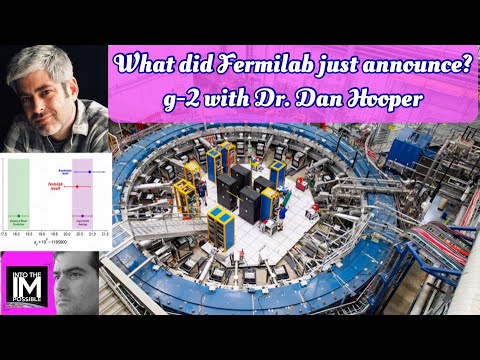For years, both electrons and muons were thought to have g-factors of exactly 2. But then in 1947, Polykarp Kusch and Henry Foley measured the electron’s g-factor to be 2.00232. The theoretical physicist Julian Schwinger almost immediately explained the extra bits: He showed that the small corrections come from an electron’s tendency to momentarily emit and reabsorb a photon as it moves through space. Does the same happen for muons?
From
00:00 Introduction
04:00 Why g-2 at Fermilab, not LHC
08:00 Who was Fermi & what does he have to do with 👽?
11:00 Wilkinson and mentorship: impossible problems.
17:45 What is a muon?
25:00 What is QCD lattice theory ?
30:00 Has this result been confirmed? Is it a fluke?
40:00 What are virtual particles?
45:00 What’s next for the muon at Fermilab?
55:00 Questions from the Audience and Clubhouse
WATCH “Is there a Fifth Force? News from the Large Hadron Collider (CERN LHCb): James Beacham & Phil Ilten”:
#cosmology #particlephysics #gminus2
Dan Hooper is a senior scientist and the head of the Theoretical Astrophysics Group at the Fermi National Accelerator Laboratory (Fermilab). He is also Associate Professor of Astronomy and Astrophysics at the University of Chicago ( ). Dr. Hooper received his Ph.D. in Physics from the University of Wisconsin–Madison. He was later a postdoctoral researcher at the University of Oxford and the David Schramm Fellow at Fermilab.
Dr. Hooper’s research focuses on the interface between particle physics and cosmology, covering topics such as dark matter, dark energy, supersymmetry, neutrinos, extra dimensions, and ultra-high-energy cosmic rays. He has authored more than 200 articles in peer-reviewed scientific journals, and he has given an even larger number of technical talks at scientific conferences and university seminars and colloquia.
Dr. Hooper is the author of three books written for nonscientists: Dark Cosmos: In Search of Our Universe’s Missing Mass and Energy, Nature’s Blueprint: Supersymmetry and the Search for a Unified Theory of Matter and Force, and At the Edge of Time: Exploring the Mysteries of Our Universe’s First Seconds ( ).
He has also written for popular magazines such as Astronomy, Sky & Telescope, and New Scientist. He gives many public lectures and is frequently called on by the media to comment on science news. Dr. Hooper’s television appearances include Through the Wormhole with Morgan Freeman and Space’s Deepest Secrets, and he has been interviewed on NPR’s Science Friday.
Professor Hooper also teaches through The Great Courses:
As the new field of astro-particle physics rapidly develops, we are witnessing an exciting time in the history of science. In addition to the progress being made in the traditional areas of experimental particle physics (accelerator experiments), exciting developments are also taking place in the use of astrophysical experiments to study elementary particles. The most striking example of this success is the measurement of the neutrino masses and mixing angles that have been made over the last decade. Many of the questions asked by particle physicists are difficult to address with collider experiments and are being explored ever increasingly by astrophysicists. These efforts include the development of particle dark matter searches, ultra-high energy cosmic rays detectors, gamma-ray telescopes and high-energy neutrino telescopes. Professor Hooper’s research is focused primarily, although not entirely, on studying and exploring particle physics beyond the Standard Model using astrophysics.
Other books mentioned in this program:
Losing The Nobel Prize by Brian Keating:
Something Deeply Hidden by Sean Carol:
Black Hole Blues and Other Songs from Outer Space by Janna Levin:
The First Three Minutes by Steven Weinberg:
Our Universe by Jo Dunkley:
Range by David Epstein:
Powered by Restream

